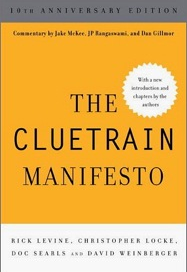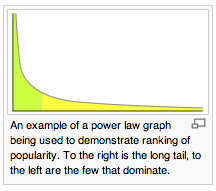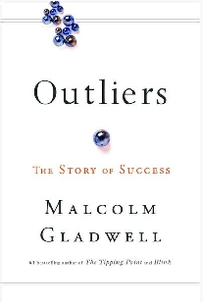
I’m not sure I learned that much from this one. It’s 10 years old and it very much reads like a manifesto, occasioned by the buzz surrounding Thomas Petzinger Jr.’s 95 Theses. (Self-aggrandizing or ironic reference to Martin Luther?…I think it’s a little bit of both, however intended.)
Petzinger’s theses pertain to how business should be done, given the fallen barriers and hyper-networking of the Internet. They include “Markets are conversations”; “Conversations among human beings sound human. They are conducted in a human voice.”; ” Hyperlinks subvert hierarchy.” After the theses, the book seems a little padded out by what read like a series of really long blog posts about the direction business, marketing and PR are heading. Ideas here aren’t really supported or described with any depth.
I don’t think that is the point of this book, though. Instead, it simply tells us that how we do business has changed, and we better accept the change. And tells us with breathless fervor. In place of depth, there is a lot of energy. In a way, it’s an inspirational book, one of the more complicated ones to be sure.
Here’s the story: To Petzinger et al, the Web functions like our collective “return of the repressed.” What was repressed: our voice and our sense of work as craft. We’ve been repressed by the industrial age the resulting corporate culture that seeks to remain branding compliant, impersonal, and risk-mitigating. The language of doing business acquired a very distinctive banal and slippery impersonality. (“It’s not language, it’s camouflage.”) Our work is no longer an expression of ourselves, but simply adhering to guidelines. (There’s no specific reference to that other manifesto writer, Marx. Nonetheless, his spirit pervades. For example, he made the same observations on alienation in the workplace.)
The Web happened the way it did in part because we’ve been silenced or mediated by that impersonality, and we wanted the means of our self-expression back. It’s the quasi-Marxist online revolution. We wanted to express ourselves in voice and in craft, and we want to experience the authentic voice and craft of others. This is what people want (supposedly) since this is how markets were first created, with people talking in open air markets about who has the best camel our how awesome their clay pots are. We got away from that because we wanted more control. But that control was stultifying. The Web returns us to the early days of the open-air market. (There is a really nice pithy summation of this historical account, but oddly it doesn’t come until the end of the book.)
Those companies who refuse to allow its business (its people) to speak authentically and use work as an expression of themselves, they are doomed. Corporations (who are by nature incapable of personality) are already on their way out, according to the Cluetrain folk.
Will the Internet return voice and craft to individuals? It’s nice to think so. So you end the book feeling pretty inspired and hopeful. Which is nice. But like any manifesto, it tends not to hold up to real scrutiny. There’s another book that needs to be written.

 I just finished
I just finished  I finished up
I finished up  Short tail on the left,
Short tail on the left,  One of the many treasures in the long tail.
One of the many treasures in the long tail.
